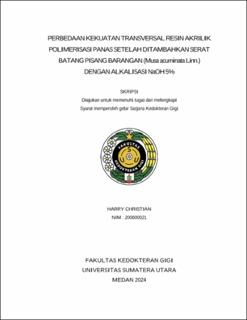Perbedaan Kekuatan Transversal Resin Akrilik Polimerisasi Panas Setelah Ditambahkan Serat Batang Pisang Barangan (Musa Acuminata Linn.) dengan Alkalisasi Naoh 5%
Differences in Transverse Strength of Heat-Cured Acrylic Resin after Addition of Barangan Banana (Musa acuminata Linn.) Stem Fiber with 5% NaOH Alkalization

Date
2024Author
Christian, Harry
Advisor(s)
Harahap, Sefty Aryani
Sari, Febby Revita
Metadata
Show full item recordAbstract
The addition of natural fibers to heat-cured acrylic resin can improve mechanical properties such as transverse strength. This research aims to investigate the difference in transverse strength of heat-cured acrylic resin after addition of 5% NaOH alkalized Barangan banana (Musa acuminata Linn.) stem fiber. The samples were heat-cured acrylic resin plates (64 x 10 x 3.5 mm) with 10 samples per group (n=10), namely group I (without the addition of barangan banana stem fiber), II (with the addition of barangan banana stem fiber alkalized with 5% NaOH for 1 hour at 25oC without coloring) and III (with the addition of 5% NaOH alkalized barangan banana stem fiber colored with 10% red dragon fruit extract). The fibers were arranged in a continuous direction and then added to mold the acrylic resin mixture (p:l = 2.3 gr : 1 ml), then pressed hydraulically and cured in a waterbath from room temperature to 74oC for 2 hours, raised to 100oC for 1 hour, then lowered to room temperature, followed by final finishing and polishing. Transverse strength testing was tested using a Universal Testing Machine with a 500 Kgf load cell at a speed of 5 mm/minute. Data analysis was carried out using One-Way ANOVA and Post Hoc LSD tests. The mean and standard deviation values obtained for groups I, II, and III respectively were 69.86 ± 3.94 MPa; 85.04 ± 6.59 MPa; 104.79 ± 7.01 MPa. There was a significant difference in transverse strength (p<0.05) for each group with a value of p=0.000. It can be concluded that there is a significant difference in the transverse strength of heat-cured acrylic resin between groups I, II, and III.
Collections
- Undergraduate Theses [1901]
